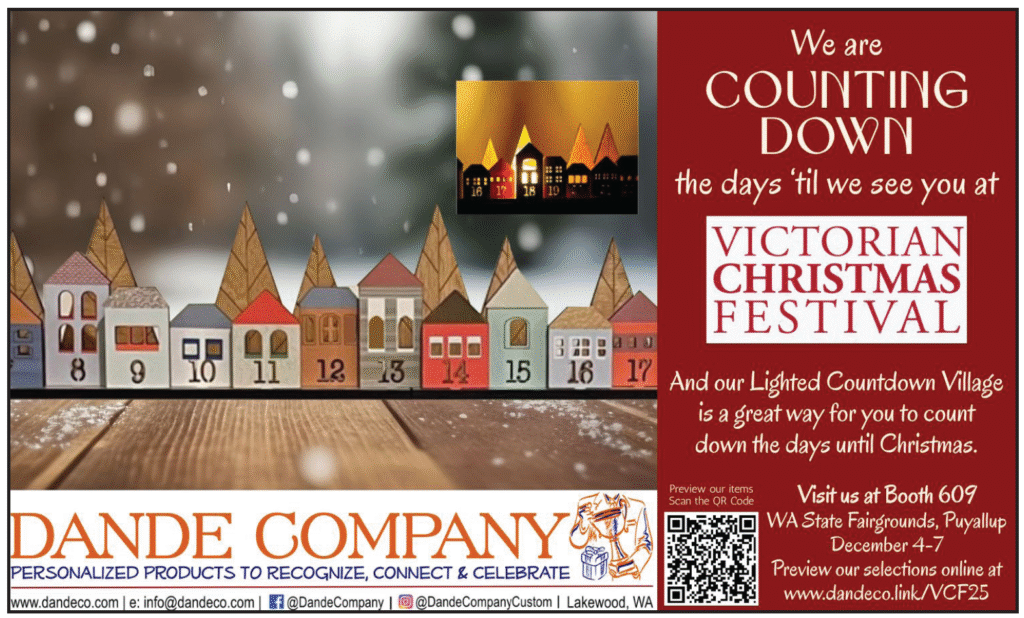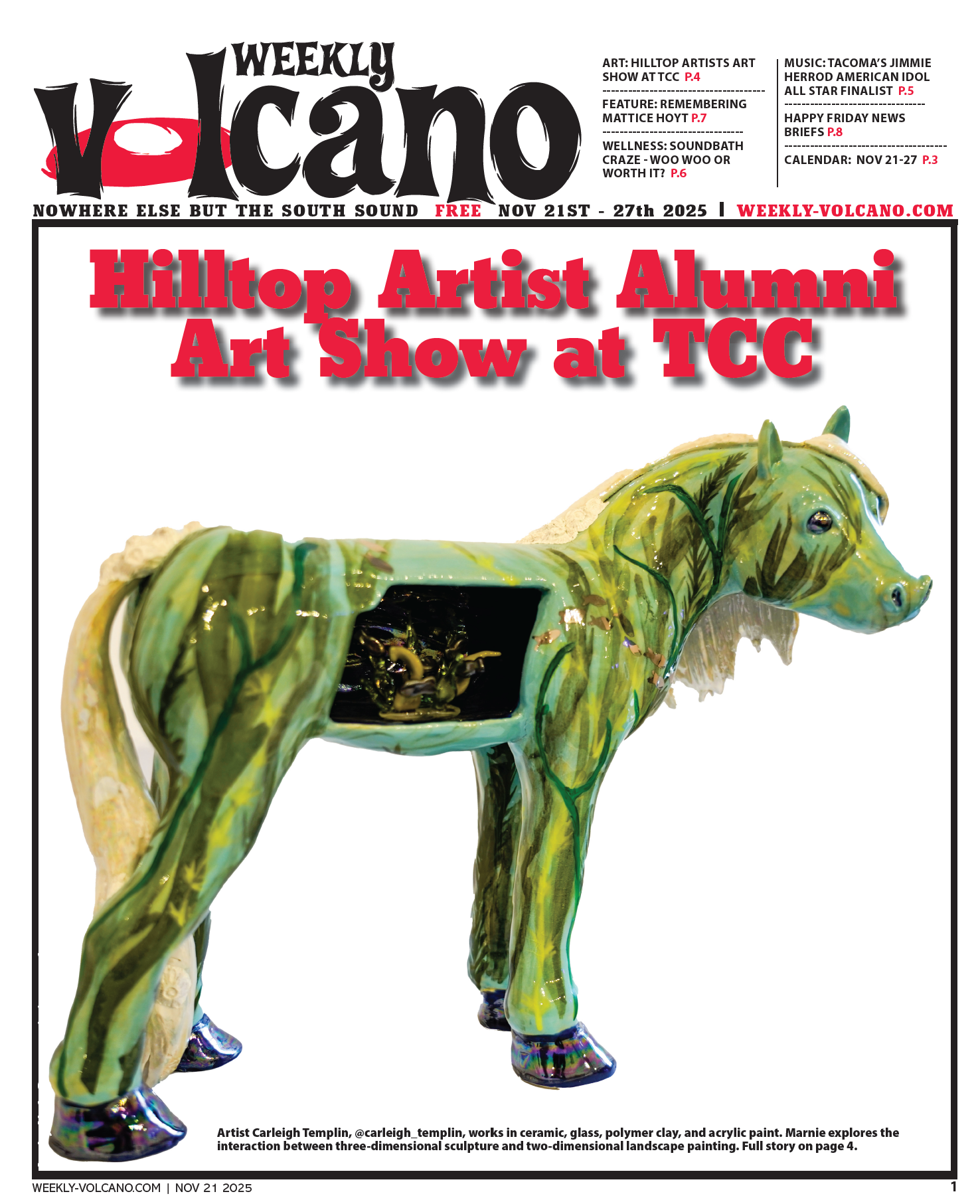BY MATT KITE for WEEKLY VOLCANO 11/28/25 |
A master gardener, a dedicated educator, and a venerated sensei. Ross Wilton, Mira Utz, and Kondo Sensei have each played a key role in replacing a beloved but dilapidated shrine at Point Defiance Park’s Japanese garden.
The project began in 2022, when Wilton, the horticultural services manager at Parks Tacoma, was inspired to replace the existing shrine, which was gifted to the city by Kokura (now Kitakyushu), Tacoma’s sister city in Japan, in 1961. More than sixty years of Northwest weather, along with sporadic vandalism, had left the shrine deteriorated. Even removing it each winter from the middle of the pond where it sits in the Japanese garden and bringing it inside could no longer rescue it from the effects of time.
Wilton knew the shrine’s days were numbered, but as someone who had honed his gardening skills for more than thirty-five years, he also knew that replacing such a culturally significant piece would require careful thought and planning.
“Japanese shrines hold great significance for the Shinto religion, which is deeply rooted in the history and culture of Japan,” Wilton says. “Shinto is a religion native to Japan that celebrates kami, supernatural spirits believed to inhabit natural elements such as rivers, mountains, forests, ancestors, and heroes. People often go to shrines to seek blessings, pray for good fortune, and purify their spirits. Their architecture also often reflects the traditional aesthetics of Japan.”
With help from Clarie Keller-Scholz, culture and heritage administrator at Metro Parks Tacoma, Wilton began exploring options to restore or replace the shrine. They first sought assistance from local Japanese carpenters, but eventually they reached out to Tacoma Sister Cities, enlisting the help of Utz, chairperson of the Kitakyushu Committee and the tutoring and resource center manager at Green River College.
Utz and Teresa Spuck, one of her co-committee members, met with Wilton and began exploring possibilities. Later that year, Spuck took a personal trip to Kitakyushu, met with representatives at city hall, and mentioned the nascent project. Utz followed up with Spuck’s newly established contacts, and soon a local artisan in Kitakyushu was identified as the ideal craftsman.
“They connected us with a gentleman named Kondo Sensei, whose family has been building these kinds of shrines and temples for more than three hundred years,” Utz explains. “He is responsible for maintaining the main shrine, the Kokura Temple. It is really meaningful that our original sister city is Kokura, which eventually merged with several other cities to become Kitakyushu. I arranged meetings to get him talking with the parks department and city representatives, and he determined that the best solution was for him to come here.”
With support from the Tacoma Parks Foundation, Kondo Sensei traveled to Tacoma to evaluate the shrine. Wilton and his team had brought it indoors, and Kondo Sensei took measurements and inspected it carefully. The moment was solemn and electric. Here was a sensei, the latest in a long line of craftsmen from his family, determining the fate of Point Defiance’s venerable shrine.
“He was so intense when he came to work,” Utz recalls. “Nobody talked. He asked lots of questions. There was this serious aura as he went through it all. Everyone in that room had been involved in getting it to that moment. It was incredible to see it move forward and to have an expert there.”
Kondo Sensei spoke of the energy of the shrine and of everyone who had played a role in building, preserving, and caring for it. His passion won over the room. Not long afterward, Utz took a personal trip to Japan and observed Kondo Sensei in his workshop teaching carpentry to high school students. It was clear that the students loved him.
“He wants to make sure to pass on those skills to the next generation,” Utz says. “He also involved some of his students in the project. It is lovely, because it aligns perfectly with the sister-city mission of people-to-people relationships and peace through people-to-people exchange to have Kondo Sensei’s students, who are learning this craft, participate in the build.”
All parties agreed on a straightforward solution. Kondo Sensei will replace the old shrine with one designed to withstand the elements for decades. Even better, he will teach Wilton and his staff how to care for the shrine so it can be preserved for future generations. Finally, he will repair and restore the old waterlogged structure, which will likely be showcased in a museum or elsewhere. It may even travel to multiple sites.
If all goes as planned, the new shrine will be revealed next year at the Point Defiance Flower and Garden Festival. In the meantime, the work is ongoing, and local residents and potential benefactors can play an important role in the project’s success.
“The funding is not coming from the Parks Tacoma budget,” Wilton notes. “This is all coming from private donations. We have managed to pay for the new one. We are now raising money for shipping it here, and anything more we raise will go toward fixing the old one. It is a great partnership between Sister Cities, Tacoma Parks Foundation, and Parks Tacoma.”
Meanwhile, anyone, regardless of heritage or ancestry, can join, volunteer for, or donate to Tacoma Sister Cities. You only need to appreciate the kind of cultural exchange that unites a master gardener, a dedicated educator, and a venerated sensei in one meaningful project.
If you would like to donate, get involved, or learn more about the project, visit www.parkstacoma.gov/project/japanese-garden-shrine






